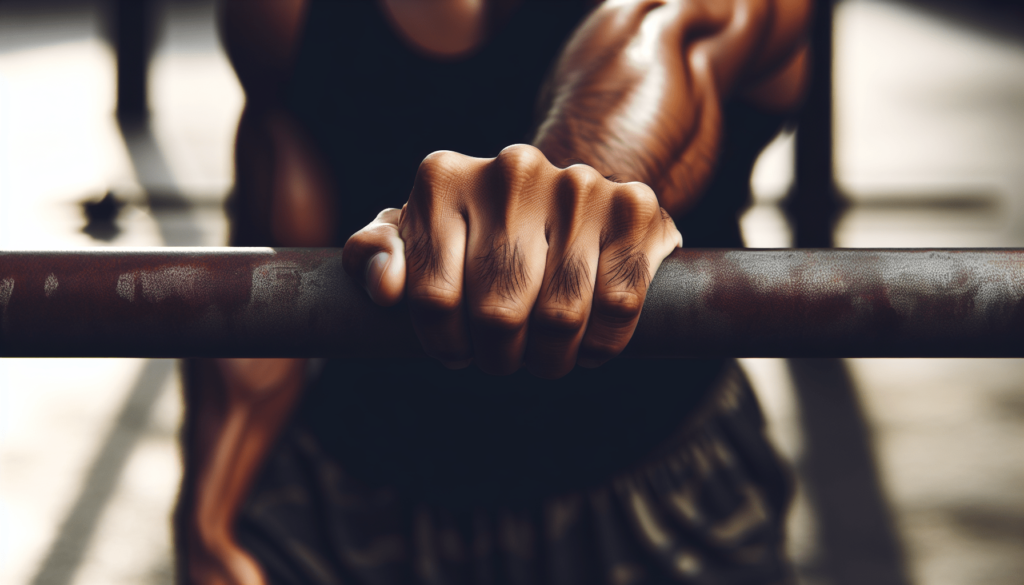Are you looking to kickstart your fitness journey but don’t know where to begin? Look no further! This article serves as the ultimate beginner’s guide to calisthenics, providing you with all the essential information you need to embark on this exciting journey. From explaining what calisthenics is to offering tips on how to get started, this guide is your go-to resource for mastering the art of bodyweight training. So, grab your workout gear and get ready to discover the incredible benefits and endless possibilities of calisthenics.
Benefits of Calisthenics
Calisthenics is a fantastic way to improve your overall fitness level and reap a variety of benefits. Incorporating calisthenics into your workout routine can lead to improved strength and muscle development, increased flexibility and mobility, improved coordination and body control, and enhanced cardiovascular endurance.
Improved strength and muscle development
One of the primary benefits of calisthenics is the improvement in overall strength and muscle development. Many calisthenics exercises, such as push-ups, squats, and pull-ups, engage multiple muscle groups simultaneously, leading to balanced and functional strength gains. As you progress with calisthenics, you’ll notice increased muscle definition and improved muscle tone throughout your body.
Increased flexibility and mobility
Calisthenics also helps to improve flexibility and mobility, which are essential components of overall fitness and daily functionality. Many calisthenics exercises, like lunges and mountain climbers, require a wide range of motion and dynamic movements, ultimately leading to increased flexibility and enhanced joint mobility. Regularly practicing calisthenics can help prevent injury and improve your performance in other physical activities.
Improved coordination and body control
Coordination and body control are often overlooked aspects of fitness, but are crucial for performing daily activities and excelling in sports and other physical endeavors. Calisthenics exercises, such as planks and mountain climbers, require coordination and the ability to regulate your body movement and balance. By consistently practicing calisthenics, you can enhance your overall coordination and body control, leading to improved performance in various physical activities.
Enhanced cardiovascular endurance
Engaging in calisthenics workouts can significantly improve your cardiovascular endurance. Many calisthenics exercises are performed in a high-intensity manner, which elevates your heart rate and stimulates cardiovascular adaptation. This adaptation leads to a more efficient cardiovascular system, allowing you to endure longer bouts of exercise and enjoy activities without feeling fatigued too quickly.
Getting Started with Calisthenics
If you’re new to calisthenics, taking the right steps to get started is essential. By following these guidelines, you’ll set yourself up for success on your calisthenics journey.
Set Clear Goals
Before jumping into any exercise program, it’s crucial to set clear and achievable goals. By having a specific purpose in mind, you’ll have something to work towards and stay motivated. For example, you might set a goal to perform 20 push-ups in a row or to achieve a full pull-up. Whatever your goals may be, make sure they are realistic and measurable, as this will help you track your progress along the way.
Consult a Physician
Before diving into any exercise program, it’s always a good idea to consult with a physician, especially if you have any pre-existing health conditions or concerns. A physician can assess your overall health and provide guidance on any modifications or precautions you should take when starting calisthenics.
Warm-Up Properly
Properly warming up your body before engaging in any physical activity is crucial for injury prevention and optimal performance. Before starting your calisthenics workout, spend 5-10 minutes performing dynamic stretches and light cardiovascular exercises to get your blood flowing and your muscles ready for action. This step will help prepare your body for the upcoming demands and reduce the risk of injury.

Basic Calisthenics Exercises
Calisthenics exercises are diverse and can target various muscle groups in your body. Here are some basic exercises to get you started on your calisthenics journey:
Push-Ups
Push-ups are a classic calisthenics exercise that targets your chest, shoulders, triceps, and core muscles. Start in a high plank position with your hands shoulder-width apart, lower your chest towards the ground, and then push yourself back up. If you’re a beginner, you can modify push-ups by performing them on your knees or against a wall until you build enough strength to perform full push-ups.
Squats
Squats are a fundamental lower body exercise that targets your quadriceps, hamstrings, glutes, and core muscles. Stand with your feet shoulder-width apart, and slowly lower your hips towards the ground as if you’re sitting back into a chair. Keep your chest lifted and your knees in line with your toes. Push through your heels to stand back up. You can modify squats by using a chair for support until you can perform them with proper form.
Plank
The plank is an excellent exercise for core strength and stability. Start in a high plank position with your forearms on the ground and your elbows directly below your shoulders. Engage your core and hold the position for as long as you can, aiming for 30 seconds to start. Make sure to keep your body in a straight line from your head to your heels. As you progress, you can increase the duration of the plank or try variations, such as side planks.
Mountain Climbers
Mountain climbers are a dynamic exercise that targets your core, shoulders, and leg muscles. Start in a high plank position and bring one knee towards your chest while keeping the other leg extended behind you. Alternate between your legs in a running motion, keeping your hips level and your core engaged. Aim for a quick and controlled movement to increase the intensity.
Lunges
Lunges are a great exercise for targeting your lower body muscles, including your quadriceps, hamstrings, glutes, and calves. Start by standing with your feet hip-width apart, take a step forward with one leg, and lower your back knee towards the ground. Make sure to keep your front knee in line with your ankle and your back knee hovering above the ground. Push through your front heel to stand back up, and repeat on the other side.
Pull-Ups
Pull-ups are a challenging and effective exercise for building upper body strength. Start by gripping a pull-up bar with your palms facing away from you, and hang with your arms fully extended. Engage your back muscles and pull yourself up until your chin passes the bar. Lower yourself back down with control. If you’re unable to perform a full pull-up, you can start with assisted pull-up variations or use resistance bands for assistance.
Creating a Workout Routine
Once you have a grasp of the basic calisthenics exercises, it’s time to create a workout routine that suits your goals and preferences. Here are some popular approaches:
Full-Body Workouts
Full-body workouts involve incorporating exercises that target various muscle groups in a single session. This approach is ideal for beginners or individuals who have limited time for workouts. A sample full-body calisthenics routine may include a combination of push-ups, squats, planks, lunges, pull-ups, and mountain climbers. Perform each exercise for a specific number of repetitions or time, and aim to complete two to three sets of each exercise.
Split Routines
Split routines involve dividing your workouts into specific muscle groups or movement patterns to allow for more focused training. This approach is more suitable for intermediate or advanced individuals who are looking to target specific areas or work towards specific goals. For example, you could dedicate one day to upper body exercises, such as push-ups and pull-ups, and another day to lower body exercises, such as squats and lunges. Rotate through different muscle groups or movement patterns throughout the week to ensure balanced training.
Progressive Overload
Regardless of the type of routine you choose, it’s essential to incorporate progressive overload into your workouts. Progressive overload involves gradually increasing the difficulty or intensity of your exercises over time to continue challenging your muscles and promoting growth. You can achieve progressive overload by increasing the number of repetitions, sets, or resistance used in your exercises. By consistently pushing yourself and gradually progressing, you’ll continue to see improvements in strength and muscle development.

Equipment for Calisthenics
Calisthenics exercises primarily rely on bodyweight movements, but some equipment can enhance your workouts and provide additional challenges. Here are some common equipment options for calisthenics:
Pull-Up Bar
A pull-up bar is a versatile and essential piece of equipment for calisthenics enthusiasts. It allows you to perform various exercises, such as pull-ups, chin-ups, and hanging leg raises, which target your upper body muscles. Pull-up bars can be attached to door frames, mounted on walls, or stand-alone structures, depending on your space and preference.
Resistance Bands
Resistance bands are inexpensive and portable tools that can add resistance to your calisthenics exercises. They are great for individuals who want to work on muscle activation and strength while modifying the difficulty of exercises. Resistance bands can be used for assisted pull-ups, squats, push-ups, and many other exercises.
Dip Bars
Dip bars are excellent for targeting your chest, triceps, and shoulder muscles. They allow you to perform exercises such as parallel bar dips and leg raises, providing an intense upper body workout. Dip bars are available in both fixed and portable options, making them suitable for home and outdoor use.
Jump Rope
Jumping rope is a fantastic way to incorporate cardiovascular exercise into your calisthenics routine. It improves coordination, cardiovascular endurance, and leg strength. Jump ropes are portable, inexpensive, and can be used in various ways to enhance your workouts.
Progressing Your Calisthenics Workouts
Once you have mastered the basics and built a solid foundation, it’s important to continue challenging yourself and progressing with your calisthenics workouts. Here are some effective ways to do so:
Increasing Repetitions
One straightforward way to progress your calisthenics workouts is to increase the number of repetitions you perform for each exercise. For example, if you can comfortably do ten push-ups, aim to increase that number by adding one or two reps to each set during your next workout. Gradually increasing repetitions will help build strength and endurance over time.
Adding Variations
Another way to progress is by introducing variations or modifications of the basic exercises. For example, you can perform decline push-ups by placing your legs on an elevated surface, or include different types of lunges, such as walking lunges or jumping lunges. Adding variations challenges your muscles in new ways, providing additional stimuli for growth and improvement.
Increasing Difficulty
As you become more proficient with the basic calisthenics exercises, you can introduce more challenging variations or advance to more challenging exercises. For instance, you can progress from regular push-ups to diamond push-ups, which place more emphasis on your triceps. You can also progress from assisted pull-ups to unassisted pull-ups or work towards more advanced skills like muscle-ups. Gradually increasing the difficulty of your exercises will help you continually progress and avoid plateaus.

Common Mistakes to Avoid
To make the most of your calisthenics journey and prevent injuries, it’s important to avoid common mistakes. Here are some pitfalls to be aware of:
Improper Form and Technique
Maintaining proper form and technique is crucial for maximizing the effectiveness of calisthenics exercises and preventing injuries. It’s important to focus on performing exercises with correct alignment, engaging the appropriate muscles, and moving through a full range of motion. If you’re unsure about proper form, consider working with a qualified trainer or seeking guidance from reliable resources.
Neglecting Rest and Recovery
Rest and recovery are essential aspects of any exercise program, including calisthenics. Your muscles need time to repair and adapt after workouts. Failing to allow adequate rest can lead to overtraining and increased risk of injury. Incorporating rest days into your routine and prioritizing quality sleep will optimize your progress and overall well-being.
Skipping Warm-Ups and Cool-Downs
Warming up properly before calisthenics workouts is crucial for preparing your body for the demands of exercise. Skipping warm-ups can increase the risk of injuries and reduce your performance. Similarly, cooling down with gentle stretching and mobility exercises after your workout can aid in recovery and minimize post-workout muscle soreness. Don’t overlook these essential components of a well-rounded calisthenics routine.
Incorporating Calisthenics into Your Lifestyle
Calisthenics is a versatile and accessible form of exercise that can be incorporated into various lifestyles and environments. Here are some tips to seamlessly integrate calisthenics into your daily routine:
Finding a Workout Space
One of the benefits of calisthenics is its adaptability to any environment. You can perform calisthenics exercises at home, in a park, or even while traveling. Identify a space that suits your needs and invest in any necessary equipment. If you prefer working out at home, set up a dedicated area with an exercise mat and any equipment you require. If you enjoy the outdoors, find a local park or open space that offers the necessary equipment or a suitable environment for bodyweight exercises.
Building Consistency
Consistency is key in any fitness endeavor. Set a regular schedule for your calisthenics workouts and stick to it. Aim for a realistic frequency that suits your lifestyle and allows for proper recovery. It’s better to have shorter, frequent workouts than irregular, lengthy sessions. Remember that regular practice is the foundation for progress and results.
Staying Motivated
Staying motivated is essential for maintaining long-term engagement with calisthenics. Find ways to keep yourself motivated and accountable. Set short-term and long-term goals to work towards. Consider joining a community or finding a workout buddy to share your calisthenics journey. Seek out new challenges and incorporate variations to keep your workouts exciting and engaging. Celebrate your achievements along the way, no matter how small they may seem.

Overcoming Plateaus and Challenges
Like any fitness journey, calisthenics may present plateaus and challenges along the way. Here are some strategies to overcome them:
Changing Rep Ranges
If you find that you’ve hit a plateau with a particular exercise, one effective strategy is to change your rep ranges. Instead of performing a fixed number of reps for each set, try incorporating higher rep sets or lower rep sets with increased intensity. By varying your rep ranges, you can challenge your muscles in new ways and elicit further adaptations.
Switching Up Exercises
Introducing new exercises or variations can help break through plateaus and keep your workouts fresh and exciting. Experiment with different exercises that target similar muscle groups or movement patterns. For example, if you’ve been focusing on standard pull-ups, try incorporating different grip variations or performing additional exercises that target your back, such as rows or inverted rows. The key is to continually challenge your muscles with novel stimuli.
Mental Resilience
Calisthenics, like any physical discipline, requires mental resilience. There may be times when progress seems slow or when you face setbacks. Stay committed and focused on your goals. Cultivate a positive mindset and remind yourself of the benefits and rewards of calisthenics. Embrace the journey, enjoy the process, and celebrate small victories along the way.
Importance of Nutrition and Recovery
In addition to regular exercise, proper nutrition and recovery play vital roles in your overall calisthenics journey. Here are some key aspects to consider:
Protein Intake
Protein is essential for muscle repair and growth. Make sure to consume an adequate amount of protein from sources such as lean meats, fish, eggs, dairy, legumes, and plant-based options like tofu and tempeh. Aim for a protein intake of around 0.8 grams per kilogram of body weight or more, depending on your goals and activity level.
Hydration
Staying hydrated is crucial for optimal performance and overall well-being. Adequate fluid intake supports important bodily functions and helps transport nutrients to your muscles. Drink water throughout the day and increase your intake during and after your workouts. Pay attention to your body’s thirst signals and hydrate accordingly.
Rest and Sleep
Quality rest and sleep are vital for muscle recovery and overall physical and mental well-being. Aim for 7-9 hours of sleep per night to allow your body to repair and recharge. Additionally, incorporate rest days into your calisthenics routine to avoid overtraining and give your muscles time to recover. Prioritize rest and sleep just as you prioritize your workouts.
In conclusion, calisthenics offers a wide range of benefits, from improved strength and muscle development to increased flexibility and cardiovascular endurance. By setting clear goals, consulting a physician, and warming up properly, you can get started on your calisthenics journey. Basic exercises like push-ups, squats, planks, mountain climbers, lunges, and pull-ups form the foundation of a calisthenics workout routine. Whether you choose full-body workouts or split routines, incorporating progressive overload is essential for continued progress. While calisthenics primarily relies on bodyweight movements, equipment like pull-up bars, resistance bands, dip bars, and jump ropes can add variety and challenge to your workouts. As you progress, increasing repetitions, adding variations, and increasing difficulty will keep your workouts engaging and effective. Avoid common mistakes, such as improper form, neglecting rest and recovery, and skipping warm-ups and cool-downs, to ensure a safe and successful calisthenics journey. By finding a suitable workout space, building consistency, and staying motivated, you can easily incorporate calisthenics into your lifestyle. Overcoming plateaus and challenges requires changing rep ranges, switching up exercises, and developing mental resilience. Finally, proper nutrition, including adequate protein intake, hydration, and rest and sleep, is crucial for supporting your calisthenics progress. Embrace the versatility and benefits of calisthenics, and enjoy the journey towards improved fitness and well-being.

